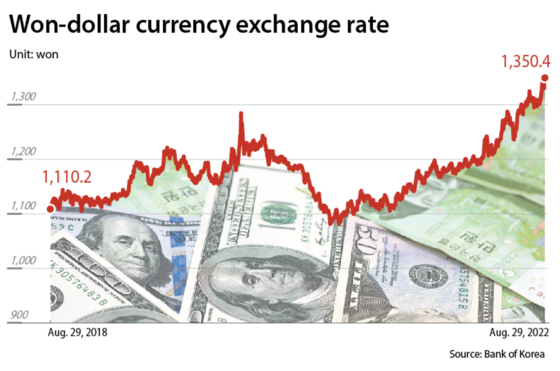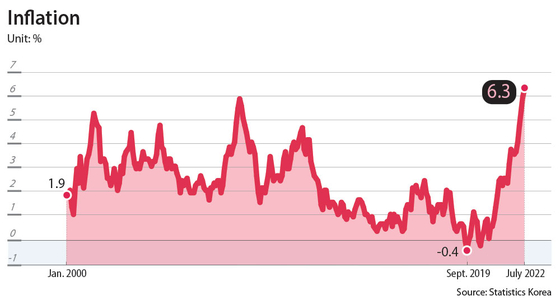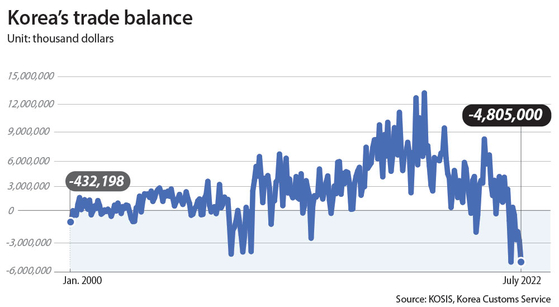[NAVIGATING CRISES] Yoon's options limited as economy in crisis
![Containers are piled up at a port in Busan. [YONHAP]](https://koreajoongangdaily.joins.com/data/photo/2022/08/30/ad0f1e6e-6d67-4240-8e94-b17c12cf3fa8.jpg)
Containers are piled up at a port in Busan. [YONHAP]
Korea has been hit with inflation, a falling won, rising interest rates, falling stock prices, a teetering housing market and, now, a trade deficit, which has been running for four months straight.
The Yoon Suk-yeol administration is doing all it can. It pushed through a record supplementary budget, cut tariffs on some items and released inventory from stockpiles to take the edge off inflation. It has cut the fuel tax and offered vouchers to help those in need.
Yoon has also verbally intervened in the markets, cut interest rates for some borrowers and may roll out a raft of industrial and export promotion policies.
The president is quickly running out of levers to pull. Options are few, and while commodity prices have eased a bit, the freight train of rising interest rates is not likely to stop soon.
He has also missed a few key opportunities along the way as confidence was high early in his term despite clear indications that trouble was coming.
The entire world is facing a crisis, and governments everywhere are trying to piece together a workable solution for the perfect storm of high inflation, low growth and falling asset prices. Korea's situation is particularly challenging due to its dependence on trade, the high exposure of the average person to property values and its death spiral demographics.

Mired in crisis
The Bank of Korea raised the base rate for the fourth straight time to 2.50 percent on Aug. 25. It was the first time that the central bank upped the key interest rate four times in a row.
Gov. Rhee Chang-yong has signaled additional increases in hopes of reining inflation.
"The current rate is in the mid-neutral rate," Rhee said. "If inflation stays high, in the 5-percent range, it will be necessary to put the brakes on inflation by raising the interest rate."
The bank revised its outlook on inflation to 5.2 percent in 2022, the highest since 1998, from the previous 4.5 percent. Inflation has already been above 6 percent for two consecutive months.
Despite the government projecting consumer prices to ease after the Chuseok national harvest holiday in September, the governor said it's likely that consumer prices won't drop sharply until the first half of next year.
"Inflation is projected to reach around 5.9 percent in the second half of the year," the central banker said following the Monetary Policy Board meeting last week.
While oil prices have been declining in dollar terms in recent months as economic growth is slowing — with the United States already in recession — in local currency terms, prices remain at record levels.
The weak won is adding to inflationary pressures.
The currency broke 1,350 won to the dollar on Monday, its weakest in 13 years and four months, and Yoon verbally intervened last week.
This year alone, the won is down more than 10 percent against the dollar. It is joined in weakness by the yen, which is at a 24-year low, and the euro, which is at 20-year lows and below 1 dollar for the first time since 2002.
Currency weakness has wreaked havoc on the balance of trade.
Exports grew 9.4 percent on-year in July, while imports jumped 21.8 percent in the same period.
The imbalance is expected to continue this month.
Korea reported a $25.47 billion trade deficit through Aug. 20 this year, already breaking the previous annual record of $20.6 billion in 1996.
As the trade deficit grows, the government said it will announce strategies aimed to boost Korea's export competitiveness. Supporting key industries, supporting export-driven industries and stabilizing supply chains are some measures the government may announce.
"Declines in the won usually create a favorable environment for imports," said Lee Jeong-hwan, an assistant professor, College of Economics and Finance, Hanyang University. "But Korea could not gain price competitiveness due to a fall in currencies of other countries that share similar export products, like Japan and China."
Facing such a crisis, the bank revised down Korea's economic growth outlook for this year to 2.6 percent from the previous 2.7 percent.

Impact on industries
The weak won is helping some businesses and hurting others.
Korea Shipbuilding & Offshore Engineering said it expects to swing to profit one quarter earlier than it had previously forecast on a stronger dollar. Automakers that receive payment in dollars are also benefiting from the weak won.
Airlines, which lease aircraft and pay for fuel in dollars, have been particularly hard hit. Korean Air Lines loses 35 billion won ($26 million) for every 10 won decline against the dollar, while Asiana Airlines faces 28.4 billion won in losses, according to local media reports. A stronger dollar also discourages people from traveling overseas.
Inventories are piling up as inflation hits demand.
Samsung Electronics reported a 1.93 trillion won loss in inventory valuation in the second quarter, which is triple the 591.3 billion won reported in the same period a year earlier.
Samsung Electronics is accordingly lowering the operation rate of production lines by 20 percent. The operation rate of the company's television plants was 63.7 percent in the second quarter, compared to 84.3 percent in the first quarter. Cell phone plant operation rates went down to 70.2 percent from 81 percent in the same period.
LG Electronics similarly cut the operation rates of its home appliances factories, like those for refrigerators and washing machines, by up to one fifth.
As the operation rate falls, demand for labor has accordingly declined.
Lotte Chemical, which faces a 400 billion won inventory valuation loss, is postponing recruitment to next year. Recruitment may be further delayed if the operation rate at the factories doesn't recover.
"We are aware that problems may arise later if we don't hire," said a spokesperson for Lotte Chemical. "But the measure is inevitable to ensure the soundness of the financial structure amid inventories that are piling up and product costs that are being cut."
The crisis is hurting small businesses.
"The situation now is even more devastating than what we experienced following the global financial crisis in 2008," said a Seoul-based importer and distributor of car seats and toys. "Back then, it was only the won that weakened. The struggles were intense but did not last this long. The difficulties we're facing now are triggered by more diverse factors, like inflation, and have built for many years since the pandemic."
Import costs from Shenzhen, China to Incheon jumped 65 percent from last March through July due to the terminal congestion and lockdowns in large cities like Ningbo and Shanghai, she said.

The government subsidies contributed to an increase in household income, but spending did not grow accordingly.
According to Statistics Korea, household income rose 12.7 percent on-year to 4.83 million won in the second quarter, largely due to Covid-19-related government subsidies, including compensation paid to small businesses.
Transfer income from the government grew 61.5 percent.
During the same period, average spending grew at 5.8 percent.
Fast food restaurants are fast increasing prices, which further squeezes budgets. McDonald's, Burger King and KFC all raised prices more than once this year, citing the rise in raw material prices.
Even ramyeon, which has been a staple especially for low-income households, is becoming more expensive.
Nongshim, which reported an operating loss in Korea in the second quarter, will raise the price of Shin Ramyun by 10.9 percent in September.
Fresh produce prices jumped. The retail price of cucumbers soared 76 percent on year as of Aug. 24, according to Korea Agricultural Trade Information (KATI). The price of cabbage went up 45.2 percent on year, while that of green pumpkin rose 66.5 percent in the same period.
Pressured by the steep price increases, consumers have turned to affordable foods, lining up to buy cheaper fried chicken offered at discount marts. Some of those chickens, sold at about half the price of franchise fried chicken restaurants, are resold on secondary online markets.
![A sign at an Emart discount store in Seoul on Aug. 22 reads that the fried chicken is sold out. [YONHAP]](https://koreajoongangdaily.joins.com/data/photo/2022/08/30/b98c0d87-9a8a-4b15-9939-0df3f79970a0.jpg)
A sign at an Emart discount store in Seoul on Aug. 22 reads that the fried chicken is sold out. [YONHAP]
Indebted punters who made bets on last year's market rally are suffering.
"Seeing real estate prices skyrocket, my wife and I decided to buy a house in January in fear of missing out on a chance to ever buy a house," said 37-year-old Seo Kyung-woo, an office worker.
Seo borrowed 450 million won in January.
"My wife and I were afraid that we may never get a chance to buy a house due to the rapid rise of the housing prices," said Seo.
For every 25 basis points rates increase, average annual interest payments increase by 163,000 won, according to central bank data.
The central bank has signaled additional rate increases, saying the current 2.50 percent is the "mid-neutral rate."
The interest rate increases will "constrain spending of low-income households that have excessively drawn out loans," the Bank of Korea wrote in a July report. "As the debt-to-service (DSR) ratio grows, the households that are constrained by spending will also grow."
DSR equals loan payments divided by income.
Korea's outstanding household credit hit 1,869.4 trillion won in the second quarter, a record, according to the preliminary data from the Bank of Korea. Household credit refers to credit purchases and loans to households extended by financial institutions.
"My interest on a mortgage recently rose to 3.69 percent from 2.43 percent last July," said Ha So-jin, a bank employee on maternity leave. "The interest rate for my unsecured loans at Jeju Bank jumped to 4.4 percent from the previous 2.6 percent, so I had to switch to a bank that offers me a lower rate. I'm so stressed about the rising rate."
"Impacts of the interest increases have not yet been clearly realized in the real economy, but could be materialized gradually over time," the central bank said.
Korea's consumer sentiment index plunged 10.4 points to 86 in July, the lowest since March 2020 (80.9). The index measures the level of optimism that consumers have about the performance of the economy. A reading below 100 indicates a deteriorating outlook.

Government measures
As inflation pressures pile up, the government rolled out policies to help individuals. The policies included an extension of pandemic-related employment retention subsidies, a 37 percent fuel tax cut on gasoline and tariff reduction. Ahead of Chuseok, the government issued a 65 billion won in vouchers for agriculture purchases.
To reduce the impact on the economy, the government announced plans to cut interest payments by as much as 50 percent for investors 34 or under and with low incomes and low credit scores. Their annual interest rate will be 3.25 percent for up to three years.
The program, scheduled to start in September, will last for a year.
"This could indeed create a moral hazard," said Won Chae-hwan, a finance professor at Sogang University. "Crypto investment isn't a daily necessity, and they invested hoping to earn a fortune. A lot of crypto investors are young people, and the support measure seems like populism to hold up the falling approval rating of the president."
The most important challenge for the government is to tame inflation.
"If inflation isn't quickly tamed, the economy may face stagflation," said Chang Min, a senior research fellow at the Korea Institute of Finance (KIF). "The current inflation is caused by the supply-side shocks. To resolve inflation, Korea has to diversify global sources of imports from its focus on China and improve the structure of the retail distribution to lower unreasonably high costs of certain products."
"At this point, reducing the trade deficit by stabilizing the import price of energy is required to stabilize the won," said Lee Seung-hoon, an analyst at Meritz Securities. "Excluding energy imports, Korea is estimated to be registering a trade surplus between $13 billion and $16 billion every month."
Recent declines in the price of oil have not yet been reflected in Korea's import price due to a one-month time lag due to transportation, Lee said.
Opinions about the outlook are divided.
"Korea's financial soundness has improved compared to the past, so the country won't be entering a crisis like it had" in the 1997 Asia Financial Crisis and 2008 Global Financial Crisis, said Chang from the KIF.
Korea was the world's ninth-largest holder of foreign reserves as of the end of July. Its foreign reserves totaled $438.6 billion as of the end of the month, compared to $33.67 billion in the same month in 1997, when the Asia Financial Crisis broke out.
Korea's GNI per capita was $35,373 last year, compared to $12,334 in 1997.
"The economy will likely worsen next year, as the global interest rates continue to rise, which will discourage consumer spending. Korea's exports will also decline if key countries like the United States and China enter recessions. So to minimize the impacts of the economic factors that are largely caused by external elements, Korea has to raise internal stability by first taming inflation," Chang added.
BY JIN MIN-JI, LEE HO-JEONG [jin.minji@joongang.co.kr]










with the Korea JoongAng Daily
To write comments, please log in to one of the accounts.
Standards Board Policy (0/250자)